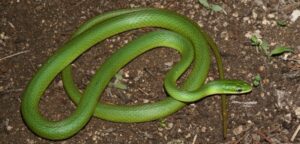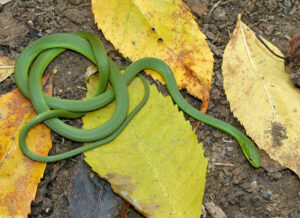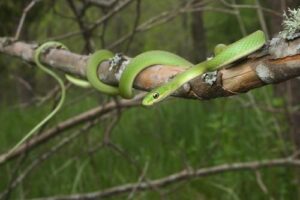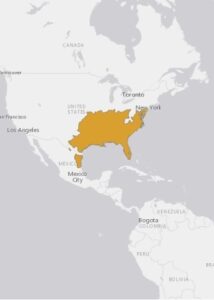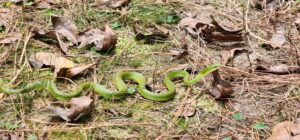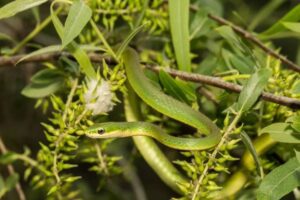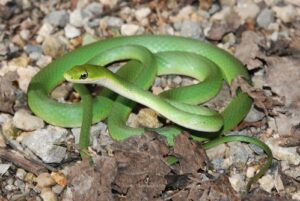The rough green snake is a North American colubrid that is sometimes referred to as the grass snake and green grass snake though these names are more commonly applied to its cousin, the smooth green snake. But the European colubrid, grass snake (Natrix natrix), is unrelated to it.
Scientific Classifications
- Suborder:Serpentes
- Family:Colubridae
- Genus:Opheodrys
- Species:O. aestivus
Conservation Status
Subspecies
This snake has two recognized subspecies.
- Northern rough green snake (Opheodrys aestivus aestivus)
- Florida rough green snake (Opheodrys aestivus carinatus)
Description
Size
The full-grown snakes get as big as 45¾ in (116 cm) in total length, including their tails.
Color and Appearance
The thin snake is bright green dorsally and has a yellowish belly. Its body color offers excellent camouflage in green vegetation, making it difficult to spot in the wild though it is fairly common in its range. The keeled dorsal scales are arranged in 17 rows at the midbody.
Are They Dangerous to Humans
The rough green snake is a very docile snake that allows close approach by humans, qualities that make it a good pet. It seldom bites, and even if it does so, it is non-venomous and harmless. It doesn’t exhibit any defense mechanism other than fleeing.
Handling of the pets should be kept to a minimum as they stress easily outside their cage. If at all they are handled, they should be held securely, close to the body, and not hung loosely from the hands.
Rough Green Snakes at a Glance
Distribution
The range extends throughout the southeastern US, from Florida, north to Indiana, coastal Maine, and west to central Texas. It is commonly found in the Atlantic coastal plain and Piedmont but not in the higher altitudes of the Appalachian Mountains. It also lives in northeastern Mexico, including eastern Nuevo León and Tamaulipas.
Habitat
The rough green snake prefers moist woodlands and meadows, often near water. The highly arboreal snake is often found climbing low vegetation and is also a good swimmer. But it is frequently found on the ground as well.
The largely diurnal snake is found coiled around tree branches at night. It gives preference to perches depending on the height and thickness of the branches and their distance from the shoreline.
Road accidents, pesticide poisoning of their prey, habitat loss, and commercial collection for the pet trade have led to a decline in their numbers in the wild.
Lifespan
Rough green snakes can live for up to 8 years.
Predators
Its predators are birds and other snakes like the eastern king snake and eastern racer. They are also infected by parasites, including the Cryptosporidium species.
Diet
It mainly eats insects and other terrestrial arthropods. But it also takes tree frogs and snails.
The snake is not a constrictor; it grabs its prey and simply swallows it alive. It relies heavily on visual and chemical cues for detecting its food and prefers live prey.
Reproduction
Oviparous (lays eggs that hatch outside the body)
The rough green snake males reach sexual maturity at 2 years of age when they are 245 mm long. Their courtship behavior consists of tail waving, head jerking, and chin rubbing. They breed in spring and sometimes, again in fall. The females lay 2-14 eggs, occasionally in communal nests shared by multiple females. The nests can be located in deep mulch, rotting stumps, under bark, boards, or rocks.
Hatchlings from the spring mating emerge in August or September and are 7.1-7.9 in (18-20 cm) in size.
Similar Species
Smooth Green Snake
The smooth green snake, Opheodrys vernalis, has smooth dorsal scales. They are not keeled like those of the rough green snake.
Care Sheet
Size of the Enclosure: A 55-75 gallon tank is suitable for housing two adults.
Temperature: The temperature of the hot side should be in the range of 85-88°F, while the cool side should be kept at 75-80°F.
Humidity: They need roughly 55-65% humidity. A bowl of clean and fresh water should always be kept in the tank setup that should be misted at least once a week.
Substrate: Reptile carpet, paper-based bedding, Aspen shavings, or cypress mulch are ideal choices for the substrate.
Feeding: The pets can be fed soft-bodied invertebrates like spiders, moths, crickets, caterpillars, and soft-bodied beetle larvae. They can also be given vertebrate prey like small lizards and tree frogs. The feeding frequency should be once or twice a week.
Source
welcomewildlife.com, animal.memozee.com, cdn.shopify.com, snake-facts.weebly.com, reddit.com, st3.depositphotos.com

